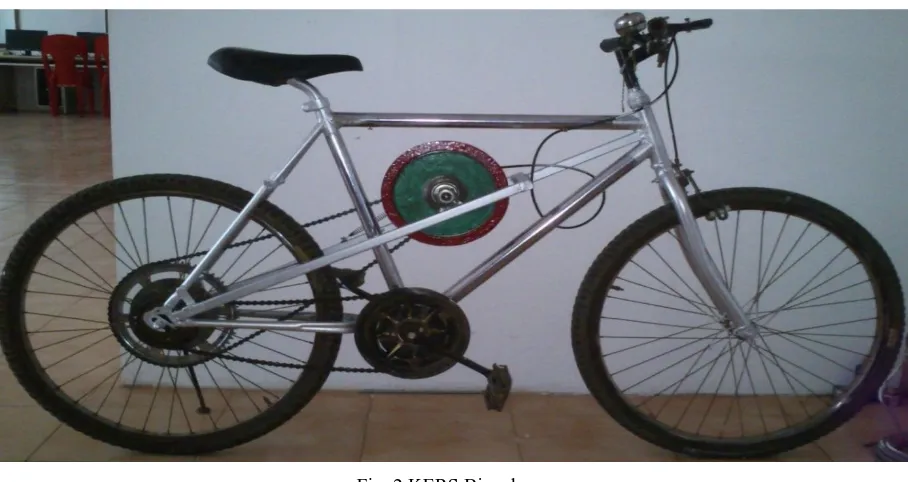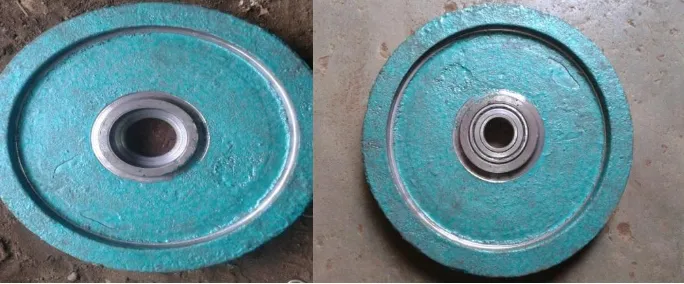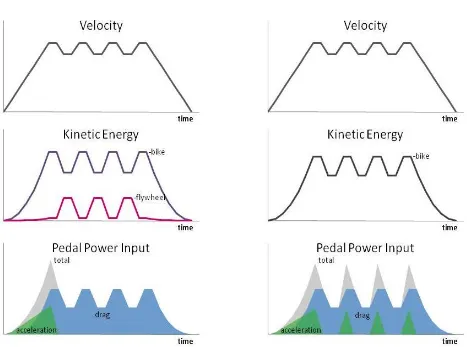DESIGN AND ANALYSIS OF KINETIC
ENERGY RECOVERY SYSTEM IN
BICYCLES
Sreevalsan S Menon
1, Sooraj M S
2, Sanjay Mohan
3, Rino Disney
4, Suneeth Sukumaran
5Final year student, Department of Mechanical Engineering, JyothiEngineering & College, Cheruthuruthy, Thrissur, India1,2,3,4
Assistant Professor, Department of Mechanical Engineering, JyothiEngineering & College, Cheruthuruthy, Thrissur, India5
Abstract: Kinetic Energy Recovery System (KERS) is a system for recovering the moving vehicle's kinetic energy under braking and also to convert the usual loss in kinetic energy into gain in kinetic energy.When riding a bicycle, a great amount of kinetic energy is lost while braking, making start up fairly strenuous. Here we used mechanical kinetic energy recovery system by means of a flywheel to store the energy which is normally lost during braking, and reuse it to help propel the rider when starting. The rider can charge the flywheel when slowing or descending a hill and boost the bike when accelerating or climbing a hill. The flywheel increases maximum acceleration and nets 10% pedal energy savings during a ride where speeds are between 12.5 and 15 mph.
Keywords: KERS, Regenerative braking, Flywheel energy storage, Flywheel bicycle, Mechanical KERS, Smart braking
I. INTRODUCTION
KERS is a collection of parts which takes some of the kinetic energy of a vehicle under deceleration, stores this energy and then releases this stored energy back into the drive train of the vehicle, providing a power boost to that vehicle. For the driver, it is like having two power sources at his disposal, one of the power sources is the engine while the other is the stored kinetic energy. Kinetic energy recovery systems (KERS) store energy when the vehicle is braking and return it when accelerating. During braking, energy is wasted because kinetic energy is mostly converted into heat energy or sometimes sound energy that is dissipated into the environment. Vehicles with KERS are able to harness some of this kinetic energy and in doing so will assist in braking. By a proper mechanism, this stored energy is converted back into kinetic energy giving the vehicle extra boost of power.There are two basic types of KERS systems i.e. Electrical and Mechanical. The main difference between them is in the way they convert the energy and how that energy is stored within the vehicle. Battery-based electric KERS systems require a number of energy conversions each with corresponding efficiency losses. On reapplication of the energy to the driveline, the global energy conversion efficiency is 31–34%. The mechanical KERS system storing energy mechanically in a rotating fly wheel eliminates the various energy conversions and provides a global energy conversion efficiency exceeding 70%, more than twice the efficiency of an electric system.
Fig.1 Flywheel KERS Bicycle
A flywheel can temporarily store the kinetic energy from the bicycle when the rider needs to slow down. The energy stored in the flywheel can be used to bring the cyclist back up to cruising speed. In this way the cyclist recovers the energy normally lost during braking. In addition to increased energy efficiency, the flywheel-equipped bicycle is more fun to ride since the rider has the ability to boost speed.The flywheel bicycle model is shown in figure 1.
II. KERSBICYCLEWORKING
A crank wheel connected to the rear wheels always rotates the clutch plate, connected in the flywheel axle. This is being achieved by using chain transmission at a specified gear ratio, crank to clutch sprocket helps us to increase the overall speed of flywheel. Now at a time when a speed reduction is required, clutch is applied which makes the contact between the clutch and flywheel. Then the flywheel starts rotating, also the speed of bicycle is decreased. Thus a regenerative braking system is achieved. On course energy is stored in flywheel. In case the brake has to be applied fully then after flywheel rotations clutch is disengaged and the brake is applied. Now when we again rides the bicycle during which we would apply clutches at this time as rear wheel rotation is lesser compared to flywheel the energy gets transmitted from the flywheel to the wheels. Now also we can reduce the overall pedalling power required in course of overrides by having clutch fully engaged. We can reduce overall pedalling power by 10 per cent. Also situation arises such as traffic jam, down climbing a hill where we do not intend to apply brake fully. For such cases we can apply our smart braking system which would allow us to decelerate and allow us to boost acceleration after this during normal riding and distance that can be covered by pedalling can also improve.
Fig. 2 KERS Bicycle
III.DESIGNREQUIREMENTS
There are many requirements that need to be met to produce a product that is both feasible and optimal. There are also some constraints, both geometric and engineering that also need to be satisfied. The following list describes these requirements and constraints:
Store energy while braking
This is the main requirement and the overall objective of the device and must be suitable to meet the rider‟s needs.
Return energy to start up
Once the energy is stored in the device, it is necessary to have a simple way to release this energy back to the user in positive way. This can be accomplished with an innovative chain drive system.
Must fit on a bicycle
This is one of the most difficult constraints to achieve and most important because we are dealing with such confined spacing. The objective is to fit the flywheel and accessories in the bicycle.
Light weight
The importance of having a light weight design is driven by the rider‟s desire to have a bicycle that is more manoeuvrable and more portable. This is also a direct trade off with how much energy can be stored in the flywheel.
Good stopping range
The stopping range is important because this product needs to be usable in real life situations. This component can be optimized to have the shortest stopping distance using dynamic analysis.
Good stopping force
The force required to stop is dependent on the stopping range and the comfort levels of the rider. It is also related to the possible flywheel features.
Inexpensive and affordable
This product must be able to make a profit and be desirable.
Safe to user and environmentally friendly
Safety is always a very important aspect whenever there is a consumer product.
Economical
The product economical and the products for this design must be cheaply available.
It is important to have a product that is reliable and this requirement will affect the normal bicycling process and must be easy to use.
Manufacturability
In order to make anything economical, it needs to be manufacturability, hence the important of having a product that can be made easily and cheaply.
Aesthetically pleasing
This is not a requirement that needs to be taken heavily, but the design should always have nice look about it, because looks will persuade the rider.
Modular
Having a device that can be adapted to existing bicycles is essential to be added to the existing ones so that it‟s easier to adopt. This also can reduce other types of manufacturing costs.
Should not hinder normal riding
To have a successful accessory for a bicycle, the ride should not feel a noticeable change in the riding performance or in the normal riding motion. A device that impedes the normal riding experience would be considered undesirable.
Controlled release
The energy that is released back to the user must be done in a safe and manageable fashion. This can be a consideration after the prototype is completed.
IV.FABRICATIONPROCESS
A. Frame Modification
The frame modification is the first part of the fabrication that has to be done. The frame has to be modified by adding steel tube. One end has to be welded at the handle end and the other at the rear wheel centre. The frame should have enough strength so as to carry the flywheel and the additional forces that comes to play. The modification should not hinder normal riding. Also the modified frame should have enough space in order to accommodate flywheel and clutch assemblies. This is shown in figure 3 below.
B. Flywheel
The flywheel has to be bored centrally in order to place a ball bearing so that flywheel can rotate over the axle. Also flywheel has to be selected so that the selected weight does not affect the bicycle physics and riding performance of the rider. The performance of KERS system mainly depends upon the flywheel selection. For clutch accessories there should be provisions in the flywheel which is used to deliver and release energy from flywheel. The works done on flywheel is shown in figure 4 below.
Fig. 4 Works on Flywheel
C. Clutch
A clutch has to be provided so as to control the power delivery and release from the flywheel. This can be achieved by providing a clutch plate that is linearly moved to and fro by applying a lever mechanism incorporated with a spring assembly for providing return mechanism. Linear clutch movements have to be made possible. For this purpose two cylindrical rods can be used. One end of the each rod was variably cut. This variable length is female part of another. One part of this is fixed near the frame side. This can be achieved by welding the part. Another part is made rotatory. This part can be rotated by applying force on it from lever via cable. This moves only partially over fixed one and firstly this is hold in position by a spring arrangement.
D. Axle
The axle has to be made so as to carry the flywheel and clutch units. The flywheel can be inserted after bearing is added to it and if variable diameter is provided on axle within mid-point the flywheel can be made to be inserted from one end and it automatically locks in the middle of the axle over which it rotates. Also the clutch units sequentially clutch plate and the fixed and moving rods along with its mechanism can be mounted over the axle. The provision for axle placement is provided in the modified frame. The axle should withstand the forces coming to play.
E. Sprocket
Two sprockets have to be used. The gear ratio is to be taken in to account here. One sprocket with higher number of teeth is to be selected and other having lesser number of teeth. The larger sprocket is to be placed at the rear wheel end and smaller sprocket at the axle end. This is to ensure that we can provide larger flywheel rotations so that energy storage increases.
Fig. 5 Fabrication flowchart
V. RESULTANDANALYSIS
The flywheel bicycle increases efficiency on rides where the rider slows often. The additional weight is outweighed by the ability to recover energy normally lost during braking. Thus the addition of extra weight does not make it difficult for the rider. Also clutch provided helps in deciding the time period of activity. The overall result is that KERS system is efficient in storing the energy normally lost in braking and returns it for boosting.
A. Weight And Performance
Normally energy stored in the flywheel is directly proportional to the weight and radius. Hence increase in weight proves to improve the performance. But as we know that the maximum safe weight that can be used is limited due to frame properties and rider compatibility. And also after some extent the radius can‟t be increased and the energy storage thus seems to be limited to some particular extend. This is also because of the fact that the total running speed is being reduced due to weight. Energy storage capacity increases with increase in weight but limitation seems to be the speed driving the flywheel. And performance of system is directly linked with the energy stored. Thus a graph can be plotted between performance and weight. Optimum value lies between 5 and 8 kg.
Energy stored in flywheel, Ek=
1
2𝐼ω 2
Where, „I‟ is the moment of inertia „ω‟ is the rotational velocity (rpm) Moment of inertia, I = 𝑘𝑚𝑟2
Where, „k‟ is inertial constant (depends on shape) „m‟ is mass of the disc
„r‟ is the radius
Thus Ek is directly proportional to the mass of the disc
down. The performance versus weight graph is shown in figure 6 and the comparison of weight of ordinary and flywheel bicycle is shown in figure 7 below.
Fig.6 Performance Versus Weightfig. 7 Weight Comparison Between Flywheel Bicycle And Conventional Bicycle
B. Comparison Analysis
Comparison is made between conventional bicycle and the KERS bicycle. The major things looked up was velocity, kinetic energy and pedal power input. The velocities of both seemed to be similar but the distance covered by flywheel is somewhat greater. A graph velocity versus time between both bicycles can be plotted. Next is the kinetic energy taken in to account. The flywheel has an extra kinetic energy that is being stored and hence from conventional bicycle flywheel bicycle is having an additional kinetic energy of flywheel. Graph connecting kinetic energy and time can be plotted. Now pedal power is taken to account. The flywheel bicycle has additional acceleration that is being boosted up by the flywheel acceleration. Hence conventional bicycle pedalling power can be achieved by less effort in case of flywheel bicycle. A graph can for pedal power input versus time.
rider of the flywheel bike doesn‟t need pedal power to accelerate! The sum of the drag and acceleration power is shown in grey. The area of this sum of pedal power input is the total pedal energy input since energy is the integral of power over time. Hence, the rider on the flywheel bicycle uses less energy than the rider on the conventional bike. This is depicted in figure 8 below.
Fig. 8 Ride Cycle comparison between flywheel bicycle and conventional bicycle
C. Overdrive Test
TABLEIOVERDRIVE TEST
Number of trials
Distance Covered
Flywheel Engaged Flywheel disengaged
1 10 metres 10.60 metres
2 10 metres 10.76 metres
3 10 metres 10.72 metres
4 10 metres 10.86 metres
VI.CONCLUSION
KERS system used in the vehicles satisfies the purpose of saving a part of the energy lost during braking. Also it can be operated at high temperature range and are efficient as compared to conventional braking system. The results from some of the test conducted show that around 30% of the energy delivered can be recovered by the system. KERS system has a wide scope for further development and the energy savings. The use of more efficient systems could lead to huge savings in the economy of any country. Here we are concluding that the topic KERS got a wide scope in engineering field to minimize the energy loss. As now a day‟s energy conservation is very necessary thing. Here we implemented KERS system in a bicycle with an engaging and disengaging clutch mechanism for gaining much more efficiency. As many mating parts is present large amount of friction loss is found in this system which can be improved. Boost is reduced because of friction. Continuously variable transmission can be implemented to this system which would prove in drastic improvement in energy transmissions.
REFERENCES
[1] Siddharth K. Patil., “Regenerative Braking System in Automobiles”, International Journal of Research in Mechanical Engineering &Technology vol.2, pp.45-46,2012.
[2] Chibulka.J.,“Kinetic Energy Recovery System by means of Flywheel Energy Storage”, Advanced Engineering Vol. 3,No. 1, pp. 27-38,1998. [3] S.J.Clegg, “A Review of Regenerative Braking System”, Institute of Transport Studies, University of Leeds, Working paper of 471, 1996. [4] SaharatChanthanumataporn, SarawutLerspalungsanti and MonsakPimsarn, “Design of Regenerative Braking System for an electric vehicle
modified from used car”, Second TSME International Conference on Mechanical Engineering, 19-21 Oct,2011. [5] Dr. IqbalHusain, “Electric and hybrid Vehicles: DesignFundamentals”, CRC press, Taylor and Francis Group, USA,2012.
[6] Gao, Y., Chen , L., Ehsani, M.,“Investigation of theEffectiveness of Regenerative Braking for EV and HEV”,SAE Paper 1999-01-2910,1999. [7] John M. Miller , “Propulsion Systems for Hybrid Vehicles”, Institute of Electrical Engineers, UK,2004.
[8] Chen, J-X , Jiang, J-Z. Wang, X-J.,“Research of Energy Regeneration Technology in Electric Vehicle”, Shanghai University Press, Vol. 7, No 2, pp.25-36,2008.




